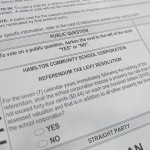Schools On The Ballot: Brown County and Wabash City
All week we are taking a closer look at the ten school referenda that will appear on ballots around the state May 3. A referendum asks voters in a particular area to choose whether to increase their property taxes to fund schools. We will follow all ten referenda and post results as they come in the night of May 3.
To help schools make up for funds lost to property tax caps or a new school funding formula, many districts have turned to ballot referenda.
Both Brown County Schools and Wabash City Schools are posing a referendum to voters next week in hopes of increasing their general funds. Both districts took a hit from the school funding formula change enacted after last year’s General Assembly.
Brown County Schools
If passed, the referendum in Brown County would give the school district an extra $1 million per year for their general fund.
Superintendent David Shafer says almost all of this money would go toward teacher salaries.
“We haven’t been able to pay our teachers what we think is a competitive level of salary for several years now,” Shafer says. “So we’ve lost some quality teachers to other school districts that can pay more.”
Shafer says teacher salaries aren’t competitive because of the money the district receives from the state declined after the legislature re-wrote the school funding formula in 2015. That formula shifted more money per student, meaning a school with high enrollment will get more money. Shafer says that model hurts the schools in his district.
“County wide districts, like Brown County, where we have enrollment decline, are penalized by the current funding formula,” he says. “I think that the formula doesn’t recognize some limitations that we have in a rural county-wide district.”
And with less money coming in than before, the district will be forced to make cost reductions, which he’s hoping the referendum will allow them to avoid.
To save money, other Indiana school districts have closed schools. Shafer says since Brown County is a rural school district, with schools are spread out over a larger area, that wouldn’t be plausible. He doesn’t want to subject kids to longer bus rides.
Shafer says a referendum is an easier way to make sure the district can continue to serve students at the level they are used to.
Wabash City Schools
Wabash Superintendent Jim Callahan also says the changes to the funding formula last year negatively affected his school district’s budget. When the formula changed, Wabash City Schools lost $518,000 from their general fund.
So to try and cover that gap, the district is posing a referendum. Callahan says over the last few years it’s been tough on their employees.
“The last five years we’ve cut 15 positions. We have not been able to keep up with cost of living at all. This past year we froze salaries and cut benefits,” he says. “In trying to close that gap we’ve had to cut some insurance benefits and some other policies like a spousal carve out where it kind of forced spouses of our employees to drop our insurance if they could get insurance through their employer.”
And Callahan says this is part of a larger issue with how Indiana funds schools. The current funding formula allocates a certain amount of money to each child. So for school districts to get more money, their enrollment has to increase.
“We’re a fairly small school, and I think a lot of schools, especially in rural Indiana where money follows kids and people are losing population, they’re losing money and funding is inconsistent,” Callahan said.
The decreasing population is something he says probably won’t change. So a referendum is one of the only ways to help keep the district’s budget afloat.

